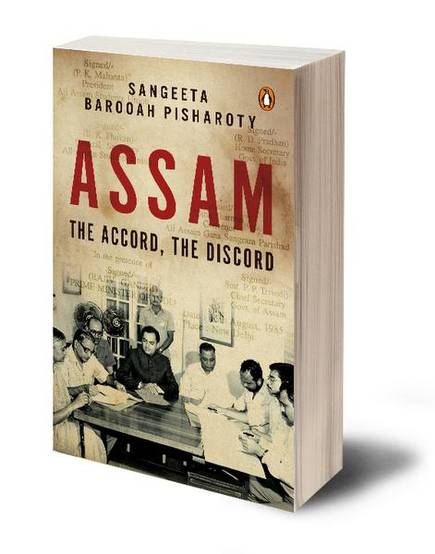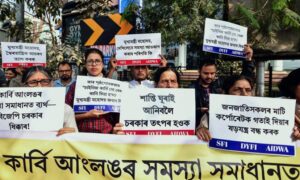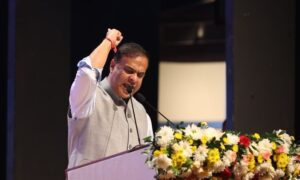
The title of Sangeeta Barooah Pisharoty’s book ” Assam- The Accord The Discord and it’s cover page depicting the signing of the 1985 Assam Accord would not prepare the reader for a pleasant surprise- that it is a comprehensive study of Assam – past and present and prospects for peace and progress. Probably it is the first of its kind attempted by an Assamese journalist in the mould of the great ” insider” John Gunther , the author of ” Inside Europe” and Inside Asia and several Area studies before and after the Second world war. This book could as well have been titled ” Inside Assam today”!
It begins with the drama of signing the Assam Accord on the 15th August 1985 to mark the end of the 6 year old Assam movement against foreign Nationals ( read illegal migrants from Bangladesh) and the beginning of a new post Accord phase of Assam politics with its primary emphasis on the preservation of the dominant role of the ” indigenous Assamese” in state power structure . This was embodied in clause 6 of the Accord in clear terms.
The first four chapters detail well known facts about how the movement began and captured the imagination of the Assamese people as never before about the existential crisis the indigenous Assamese faced from the illegal migrants and created a ” now or never” psyche to stamp out the perceived menace . This, the author argued led to ethnic tensions, ” anti migration riots” and militancy. The state response to the movement especially during spells of the President’s Rule and extension of the Armed Forces Special Powers Act 1958 didn’t improve the situation ; and finally the Accord which the author argued institutionalized” regionalism in state politics”.
The fifth and sixth chapters provide a detailed assessment of how the Assam Gana Parishad, the political platform of the Assam movement ruled Assam in two spells which destabilized the polity and especially economy as it had no development agenda; and when the ULFA militancy grew with the connivance of the state machinery. This period of misrule made ” extortion” by militants a regular affair that compelled an exasperated Planning Commission to note later in its Assam Development Report 2002 that ” unless extortion by various insurgent groups which seems to have been the fastest growing activity is brought under control, industrial growth is unlikely to accelerate.” When Tea and oil , backbone of the state economy could not bear extortion bids further the Centre intervened for actual governance failure. However by then the author noted ” a subnationalist political space had been firmly established” when the Congress under Shri Tarun Gogoi was voted to power in 2001. In these sections the author could have thrown light on a question that troubled Indians across the country: how could the extremist groups of the Assam movement whose object was to stop illegal migration from Bangladesh allow themselves to fall under the patronage of Bangladesh and Pakistan’s ISI as documented in Bertil Lintner ‘s Great Game East? The author could have spared some thoughts on this issue while covering ” Operation Bajrang” launched by the Army against ULFA.
The next two chapters deal with the complex issues and circumstances which led to the beginning of the NRC update exercise- a process that now attracted global attention as documenting on such a large scale of residents to identify aliens and deport them has not been attempted in any country after the Second world war; and how the Partition narrative of division of India on the basis of religion enabled BJP to spread its influence among diverse Hindu groups- to begin with the Bengali and Hindi speaking people and later a sizeable section of the Assamese Hindus. The author aptly described the process’ take over’ as implicit in the BJP-AGP alliance is the acceptance of the position that in the NRC process and the follow up action it entails a distinction will be made between the Hindus who sought shelter and the Muslim illegal migrants. This signals the end of the “Assam movement against foreign Nationals” as it was originally launched in 1979. Now, after release of the Final NRC update on 31 August which excluded 19.06 lakhs of assorted groups of residents from the indigenous Assamese to the long time Nepalese residents over and above the Bengali Hindus and Muslims a veritable Pandora’box has been opened in the Northeast. Though it is too early to tell about its final outcome, but one thing is certain that given the global situation and India’s relationship with Bangladesh deportation of a significant number of illegal migrants can be ruled out. We must take note of the view of Lord Meghnad Desai published in the 22nd September 2019 issue of the Indian Express daily that as the number Excluded in the NRC is 5% of the total, the statisticians would dismiss these numbers as ” random measurement errors”. He felt that ” the easy and statistically sound way would be to say that no body will be excluded whatever their papers”.
The last five chapters cover a wide range of issues of discord- the land, the language, roots of the Assamese identity from the loss of the Ahom state power especially from 1826 when Burma ceded the Ahom territory referred to in the Gazetteer as ” Assam proper” comprising 5 Districts- Kamrup, Nowgong, Darrang,Sibsagar and Lakhimpur to the British East India Company under the terms of the Treaty of Yandabo. While I see some strength in the analysis of facts and the conclusion drawn, selective use of data, use of expressions like ‘ Greater Assam’ and over emphasis on the inter group power game in pre and post 1947 Assam rather than geo economic and political compulsions which shape public policies and discourse have rendered her main ‘contents’ somewhat weak as argued below:
“Assam proper” was a depopulated, resource poor area with little revenue growth potential when the British took over and placed it under Bengal Presidency along with the coastal Districts of Burma. Bengal Presidency was in the words of the historian Chris Bailey the ” British bridge head” in India and in 1826 its jurisdiction extended to the whole of today’s UP, Bihar,Odisha and undivided Bengal. Thus Assam and North East Hill areas were a minor part of the Presidency.
Prospects of Tea, oil, minerals and later jute and strategic considerations led to the decision in to carve out the chief Commissioner’s Province of Assam from Bengal Presidency in 1874 which might have been notified as the North Eastern Province as it included the Hills and the Frontier Tracts . It must be noted that to make the Province financially viable 3 large, populous and revenue yielding districts of Bengal Presidency were” transferred” to Assam- Goalpara which was earlier carved out of Rangpur District of Bengal and Tea Districts of Sylhet and Cachar. Consequently 1901 census records show that “Bengali was spoken by 48% and Assamese 22%of the population, the rest being Hindi, Adivasi and Tribal languages of the Hills and plains ; and significantly in the “Tea Districts of Darrang and Lakhimpur , the Gazetteer noted that the” proportion of the Foreigners ( meaning Adivasi migrant labour from Central and Eastern India)is very large and in Darrang Assamese was returned by little more than half the population and in Lakhimpur by only 39%”.( Ref page 48- Gazetteer of Bengal and North East India by B.C. Allen and E.A.Gait etal).
Under Curzon’s Partition of Bengal scheme Assam became a part of the Province of Eastern Bengal and Assam with Dacca as its capital.
Even after the annulment of the” the Partition of Bengal” when Assam became a Governor’s Province, the 3 transferred Districts remained in Assam; and this continued after Sylhet referendum in 1946 when Karimganj part of Sylhet was awarded to India. Presently 10 out of 33 Districts of Assam form parts of the same 3 ” transferred” Bengal Districts. Thus there has always been an” East Bengal” part in the composite state- a fact ignored by the media as ethnic Bengali people in Assam are perceived as migrants when most of them had in fact their ” domicile in India at the commencement of the Constitution” and therefore entitled to citizenship under the article 5 of the Constitution.
Though Assam was elevated to a Governor’s Province it continued to be under the jurisdiction of Calcutta High Court ; and as no separate University was established nor Law ,Medical and Engineering Degree colleges, the growth of the ” middle class professionals” was tardy. Interestingly, Dacca University established after the short lived Partition of 1906-12 continued and made a huge contribution to the spread of higher education and growth of the middle class in East Bengal and especially among the Muslims. Further the conventional perception that the Bengali Hindus were ” brought” by the British who were responsible for introducing Bengali in field administration and education is somewhat unfounded for two reasons. First, most of the officials were drawn from the ” transferred” Districts especially Sylhet where an English educated class was already in position. One may recall that Bipin Chandra Pal, the great nationalist leader of the ” Lal – Bal- Pal ” trio leadership of the ” extremist” group within the Congress ( Lala Lajpat Rai and BG Tilak were the other two leaders) was from Sylhet. The point of ” imposition” of Bengali is also debatable as the historian JB. Bhattacharjee pointed out that Bengali was used by the Ahom Kings in making correspondence with the rulers of Coochbihar for years before the British take over. The fact that use of Persian wasn’t there in ” Assam Proper” Bengali was a practical option for field administration and school education initially for want of text books as pointed out by the author. In fact the policy of the colonial government was to use Bengali as the entry point language in Assam ; as for instance before Thomas James began use of Roman script for teaching Khasi, the first Khasi New Testament was published in 1824 by William Carey in Bengali script.
The author ends with a note of despair as the main agenda of the Assam movement- securing a constitutionally guaranteed ” primacy of the indegenus people in electoral politics and economy” of Assam as the author succinctly put it is unlikely to be realised as it is against ” the basic structure ” of the Constitution and the principle of universal adult franchise. There is also the undeniable fact of the settlers unrivaled role in the economy as ” drivers of growth” in all sectors especially in Tea,Jute, dairy develelopment ,wholesale and retail trade and real estate etc . Economic development after all is at once a product measurable in terms of GDP and a process involving every one either as a saver, producer and seller or a buyer.The economic growth process is always inclusive in the sense that it doesn’t make a distinction between an indegenus and migrant in transactions. Thus the contribution of the settlers to Net State Domestic Product of Assam must be critical as in other NE states.
The 21 July 2015 decision of the Supreme Court to regard Tea Tribes who came as migrants after the British take over of Assam in phases as ” original inhabitants of Assam” has clearly broadened the definition of indegenus people and thereby prepared the ground for claiming similar recognition by other such groups like the jute farmers who migrated to Assam about a century ago. In fact the demography of today’s Assam is the outcome of the colonial extractive mode of production founded on commercial cultivation of Tea andJute, extraction of lac and timber ,mining ,oil and gas industry which entailed migration of labor, modern skills and capital to a region where labor was in short supply as in Sri Lanka or Malay Peninsula when they came under the British and experienced similar change in demography.
A major lesson of post second world war history is that the rural demography cannot be changed by administrative action : It needed a civil war and ethnic cleansing- the kind of situation that drove the Sikhs and Hindus from Pakistan following division of India or what drove in 2017-18 the Rohingya Muslims out of Rakhine in Myanmar.
It appears also that the author has not taken into account the changing religious demography of Assam since 1971 which has a direct bearing on the political prospects of the indigenous people. H.N.Das, former Chief Secretary to the Government of Assam noted in his article entitled – Political Reorganization of Assam in ” Perilous journey”- a 2011 Maulana Abul Kalam Azad Institute of Asian Studies Publication that the ” Assamese Hindus comprise only 29.30% of the population of Assam as per 2011 census, that is, about 50% of the Hindu population estimated at 61.47% of Assam’s population – among the lowest in the country and the rest being Bengali, Nepalese, Hindi speaking and other Hindu groups . A related issue is the steady decline of the Hindu population since 1971 in Assam and the North East – a development which according to the media reports has been mainly due to out migration of the Bengali, Nepalese and Hindi speaking Hindus which points to the strategic importance of non Assamese Hindus in State politics. This is the issue the Hindu Right has capitalised to bring about Hindu consolidation in Assam which has been steadily eroding the base of the ” indegenus identity politics” as a good number of AGP and even Congress leaders are flocking to the BJP fold.
Thus it’s a Hobson’s choice for the multi ethnic and multi lingual political society of Assam , that is to reconcile history with demography and to act upon the other lesson of the post Second world war that ” Geography is the economic destiny of Nations”. The latter was underscored in the Vision 2020 Document of the North Eastern Council wherein ” opening up the Sea route through Chittagong Port and the land route through Bangladesh” were viewed as critical strategic need for development of the land locked North East. And time is most opportune now to move in this direction as the Bangladesh economy – placed by the IMF in the category of the “Emerging economies” is surging to the ” middle income” group as her $ 1750 per capita income ( 2017-18 )is much higher than Assam’s per capita NSDP and likely to equal soon India’s $2020 per capita income as it has been growing @ 6.5% over the past decade.” In 1974 just 9% of Bangladesh lived in urban areas, today 37% do. In a few decades 50% will do” the Economist observed in its September 14,2019 issue. This may even suggest that a good number of illegal Bangladeshi migrants who moved to Assam in the 70’s might have gone back to Bangladesh when its economy picked up creating jobs in the expanding urban sector and due to the hostile environment to their presence created by the Assam movement and the measures to detect illegal migrants. This period also saw huge movement of Bangladeshi skilled and unskilled labour to the Gulf, Europe and North America. According to the UN, presently the share of Bangladesh in the global diaspora was 2.5% as compared to India’s 6% of the total which speaks volumes of spread of the Bangladesh labour across the world especially in advanced economies.
Written in a racy style Assam Accord and Discord is a fascinating and insightful account of Assam politics of today and her prospects for peace and development and is a ” must read ” for any one seriously interested in the developments in Assam and North East India.
I cannot but mention that I have noticed several avoidable factual errors and omissions which left a jarring note and merit attention of the author. Some of these are stated below:
.page 251 –” no region other than Sylhet went for Referendum” is not correct as North West Frontier Province also went for Referendum in 1946 as embodied in the June 3 Declaration .
… page 316– Chittagong Hill Tracts were always under the Chittagong Division of Bengal Presidency during the British period and never under Sylhet division.
… page 295 … Maulana Abdul Hamid Khan Bhasani was the name and GK Pillai was Union Home Secretary and not Cabinet Secretary. Dr. R. Mitra who was lynched by the mob was a distinguished scientist and held a very senior position in the OIL India. And perhaps the assassination of two other senior I.P.S. officers- Subir Deb and Negi could have been mentioned.
The author has provided an answer to Assam’ dilemma by a quote from the Bard of Brahmaputra , Bhupen Hazarika – his clarion call to the rise of the New Assamese embracing everyone living in Mother Assam.
[the_ad id=”17325″]


















